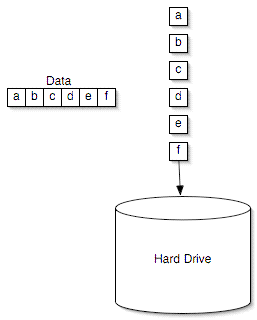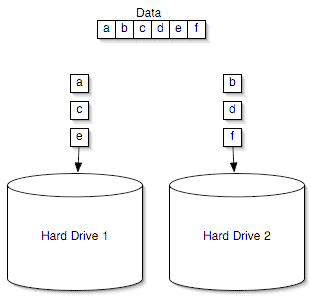Western Digital's Raptors in RAID-0: Are two drives better than one?
by Anand Lal Shimpi on July 1, 2004 12:00 PM EST- Posted in
- Storage
Doubling Theoretical Performance: RAID-0
For those of you who are already familiar with RAID and how it works, go ahead and skip to the benchmarks; these next two pages are designed to serve as brief introductions to the two most common forms of RAID on the desktop: RAID-0 and RAID-1.Otherwise known as striping, RAID-0 is the only performance-enhancing form of RAID that we'll be talking about in this article. The premise behind striping is simple. Data being written to a drive is split into "stripes", generally 16 - 256KB in size, with each stripe being written to a different drive in the array. For example, say we were dealing with a 2-drive RAID-0 array with a stripe size of 128KB and we wanted to write 256KB of data; drive 0 would get the first 128KB of data written to it, and drive 1 would get the remaining 128KB.

Writing to a single hard disk

Writing to a two-disk RAID-0 array
Here, you can see that the write performance of RAID-0 can be almost double that of a single drive, since twice as much data gets written at the same time. The higher write performance is obtained at the expense of some controller overhead, since the RAID controller has to handle splitting up data into stripes before sending it to the drives themselves - but with modern day microprocessors being as fast as they are, the overhead is usually thought of as negligible.
Reading works the exact same way, but in reverse. Say that we want to read that same 256KB of data back; we pull one stripe from drive 0 and the other stripe from drive 1. The read is now completed in half the time, theoretically doubling performance.
We are careful to use the word "theoretical" because the performance advantages of RAID-0 disappear quickly if we're not dealing in ideal situations like the ones we just described. If too large of a stripe size is used, then the performance advantages of RAID-0 can be lost, while too small of a stripe size could result in excess overhead, reducing the performance improvement of the striped array.
We have seen in the past that for most desktop applications, the largest stripe size that a desktop RAID controller will offer is usually the best choice for performance. With Intel's ICH5/6, that translates into a 128KB stripe size, which for our comparison is what we decided to go with. The other stripe size options didn't offer any better performance for our desktop test suite.
The main downside to RAID-0, other than cost, is reliability. The size of a RAID-0 array is the sum of all of its members; so, two 100GB drives in a RAID-0 array will give you one array with a 200GB total capacity. Unfortunately, if you lose any one of the drives in the array, all of your data is lost and isn't recoverable. Since two drives are working in tandem and are both necessary to hold your data, you effectively halve the mean time between failure by moving to a two-drive RAID-0 array.










127 Comments
View All Comments
Insomniac - Thursday, July 1, 2004 - link
I was wondering how RAID1 reads back data. I thought if it was smart, it would use both drives and improve performance. If that wasn't the case, I wondered if you could choose which drive it read from. That way, you could get a WD Raptor II and a low cost 80GB hard drive to pair up. You get the redundancy and speed of the Raptor for a lower cost. What about RAID5? (I know the ICH5/6 doesn't support it, but I thought there were some chipset m,akers that did. I would like to see what that brings to the mix. Given the choice right now, I'd take redundancy over performance. Maybe RAID 5 can give you both for less than 0+1.Pollock - Thursday, July 1, 2004 - link
I really wish some regular 7200 RPM drives had been used, considering someone who can afford a 74GB Raptor won't care about the costs of RAID anyway. =P Besides, to me it seems like Raptors already perform so well that it's hard to find any performance gain anyway. I was also under the impression that a lot of people with SATA drives in RAID 0 were actually getting much more noticeable performance gains; i.e. outperforming lone Raptors. Well, whatever.goku21 - Thursday, July 1, 2004 - link
I noticed that they came to the conclusion of only using 2 drives in a RAID setup, but in my expereince the more drives the supposed increase in performance. Perhaps they should revisit this with 4 Raptors in a RAID setup.kuk - Thursday, July 1, 2004 - link
Just one small thingy ... why is the manufaturer stated in the article summary "3Com/U.S. Robotics"?parrybj - Thursday, July 1, 2004 - link
While your overall disk bound throughput may be higher, seek times are sill only as fast as the slowest drive in the array. Since seek time is a more important desktop performance metric, I would think there would be very little benefit to doing this.Marlin1975 - Thursday, July 1, 2004 - link
Well the review was nice if you are thinking of running 2 raptors on a ICH5/6 SATA ports, but what about the other 99% of use that may use VIA, SiS, etc.. and/or other 7200 rpm hard drives?Matthew Daws - Thursday, July 1, 2004 - link
I'd be interested in seeing how using RAID0 with older drives, or one old drive and a newer drive, works out. If you're upgrading your motherboard, then given that RAID comes "for free", it could be a good way to save money by buying a second, smallish hard-drive, and using your old hard-drive with this new one in parallel...parrybj - Thursday, July 1, 2004 - link
Very good article. The results are not surprising. I have one comment about RAID1. While in theory it is simply a data redundancy mechanism, in practice there are performance benefits. Any good RAID1 algorithm will use read optimizations that will allow for parallellism during read requests. Thus, under the right conditions, most RAID1 arrays will achieve higher read IOPS than a single drive. Also, there may be a performance hit on writes due to the fact that writes will only be as fast as the slowest drive.djm2cmu - Thursday, July 1, 2004 - link
#4: Excellent introduction to all the common RAID levels here: http://www.acnc.com/04_01_00.htmlnofuse - Thursday, July 1, 2004 - link
This article doesn't seem to be up to the standards I've come to expect from Anandtech.It would be more fair to say "Intel's onboard RAID 0 solution offers no performance gain." I'd be interested to see results from other RAID controllers. You can't take one product and make a blanket comment like "RAID 0 is not worth it." That would be like me reviewing an NVIDIA Vanta graphics card and saying "3D acceleration is not worth it."